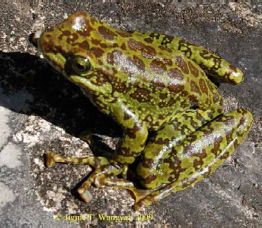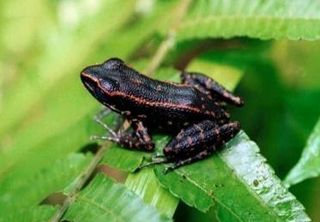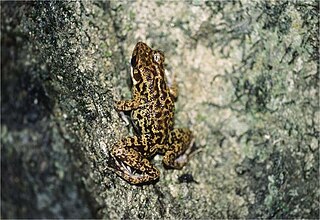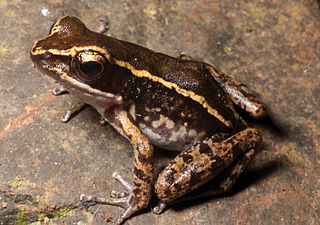
Laguna Blanca National Park is a National Park in the west of the province of Neuquén, Argentina, close to the town of Zapala.
Nymphargus mariae, commonly known as Maria's giant glass frog, is a species of frog in the family Centrolenidae. It is found in the cloud forests of the Serranía de Sira, Huánuco, Peru and in Ecuador. A population endemic to Ecuador was previously considered to be a distinct species, Nymphargus puyoensis, but is now classified as a junior synonym.

Amolops mantzorum, commonly known as the Sichuan torrent frog or Kangting sucker frog, is a species of frog in the family Ranidae. It is found in Gansu, Sichuan, and Yunnan Provinces of China. It has recently been reported also from Bhutan.

The common green frog is a frog species of in the true frog family Ranidae; some sources still use the old name Rana erythraea. It lives in Southeast Asia and is also known as green paddy frog, red-eared frog or leaf frog. The last name, however, commonly refers to the Neotropical tree frogs which make up the subfamily Phyllomedusinae. These are not closely related to H. erythraea, belonging to family Hylidae instead.

Pulchrana siberu, also known as the Siberut Island frog, is a species of true frog, family Ranidae. It is found in the Mentawai Islands, off the Sumatran west coast (Indonesia), including the eponymous Siberut Island. It possibly occurs in Sumatra itself, although the latter records seem to refer to an as-yet-undescribed species. Similarly, earlier records from Malaysia refer to Pulchrana centropeninsularis.

Pulchrana baramica, the Baram River frog, brown marsh frog, or masked rough-sided frog, is a species of "true frog", family Ranidae. It is found in the Malay Peninsula, including the extreme south Thailand, Peninsular Malaysia, and Singapore, and in the Malay Archipelago, including Borneo, and the Indonesian islands Java, Sumatra, and Bangka Island. Its type locality is the Baram River in Sarawak, Malaysia, giving it one of its common names. Its natural habitats are tropical moist lowland forests and swamps. It is not considered threatened by the IUCN.

Pulchrana picturata, also known as the spotted stream frog, is a species of frog in the family Ranidae. It is endemic to Borneo.
Pulchrana banjarana is a species of true frogs, family Ranidae. It is endemic to the Malay Peninsula, occurring from the extreme southern Thailand to Peninsular Malaysia; however, it might also occur in Sumatra (Indonesia). The specific name banjarana is derived from the Malay word for "mountain range", banjaran, and refers to the distribution of this species in the highlands of the Malay Peninsula.
Pulchrana debussyi is a species of true frog, family Ranidae. It is endemic to Sumatra, Indonesia. It is only known from its type locality in the Batak Mountains. The holotype is now lost, and there are concerns about validity of this taxon—it might be a synonym of Sylvirana nigrovittata. Common name Battak frog has been proposed for it.

Pulchrana grandocula, also known as the big-eyed frog, is a species of "true frog", family Ranidae. It is endemic to the southern Philippines and occurs on the islands of Basilan, Bohol, Camiguin Sur, Dinagat, Samar, Siargao, Bucas Grande, and Mindanao. Some populations from Mindanao formerly assigned to this species are now recognized as a separate species, Pulchrana guttmani.
Pulchrana laterimaculata, also known as the side-spotted swamp frog, is a species of "true frog", family Ranidae. It is found on the Malay Peninsula from the southernmost Thailand through Malaysia to Singapore, in Sarawak in Borneo, and on the Natuna Besar island in the Indonesian part of the South China Sea.

Pulchrana moellendorffi, also known as the Culion frog, is a species of "true frog", family Ranidae. It is endemic to the Palawan Island group of the Philippines. It inhabits streams and rivers in lower montane and lowland forests. It is threatened by habitat loss.

Hylarana similis is a species of true frog in the genus Hylarana. It is native to Luzon and surrounding smaller islands in the Philippines. Its natural habitats are subtropical or tropical dry forests, subtropical or tropical moist lowland forests, rivers, intermittent rivers, freshwater marshes, and intermittent freshwater marshes. It is threatened by habitat loss.

Pulchrana mangyanum is a species of "true frog", family Ranidae. It is endemic to the Philippines and occurs on Mindoro, Sibay, and Semirara islands. Prior to its description in 2002, Pulchrana mangyanum was confused with Pulchrana signata.
Pulchrana fantastica, also known as the splendid stream frog, is a species of "true frog", family Ranidae. It is endemic to northern Sumatra (Indonesia) and is currently known from the Aceh and North Sumatra provinces. Its nearest relatives are Pulchrana centropeninsularis and Pulchrana siberu. The specific name fantastica is derived from the Greek phantastikós and refers to the "extraordinary beauty" of this frog.
Pulchrana centropeninsularis is a species of "true frog", family Ranidae. It is found in Peninsular Malaysia and Sumatra (Indonesia). The specific name centropeninsularis refers to the area of its original discovery, the state of Pahang in the central Peninsular Malaysia. Later on, it has also been recorded in the province of Jambi in east-central Sumatra. Pulchrana centropeninsularis is a rare species known from few individuals only. Prior to its description, Pulchrana centropeninsularis was confused with Pulchrana siberu, its closest relative.










